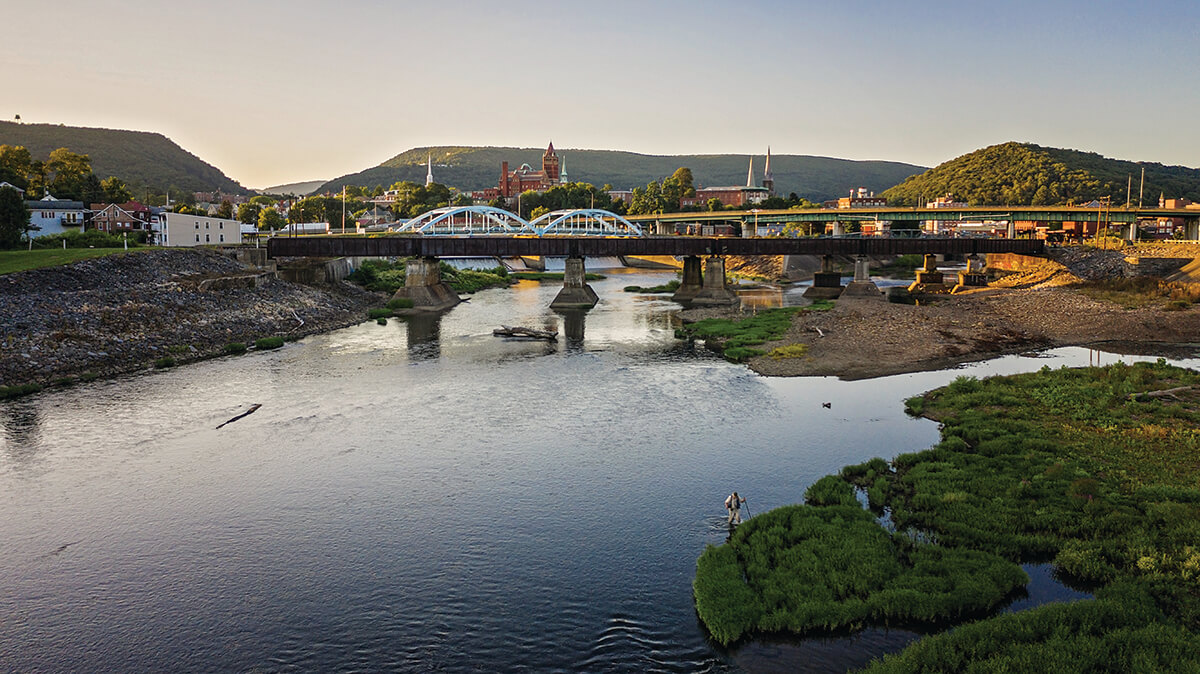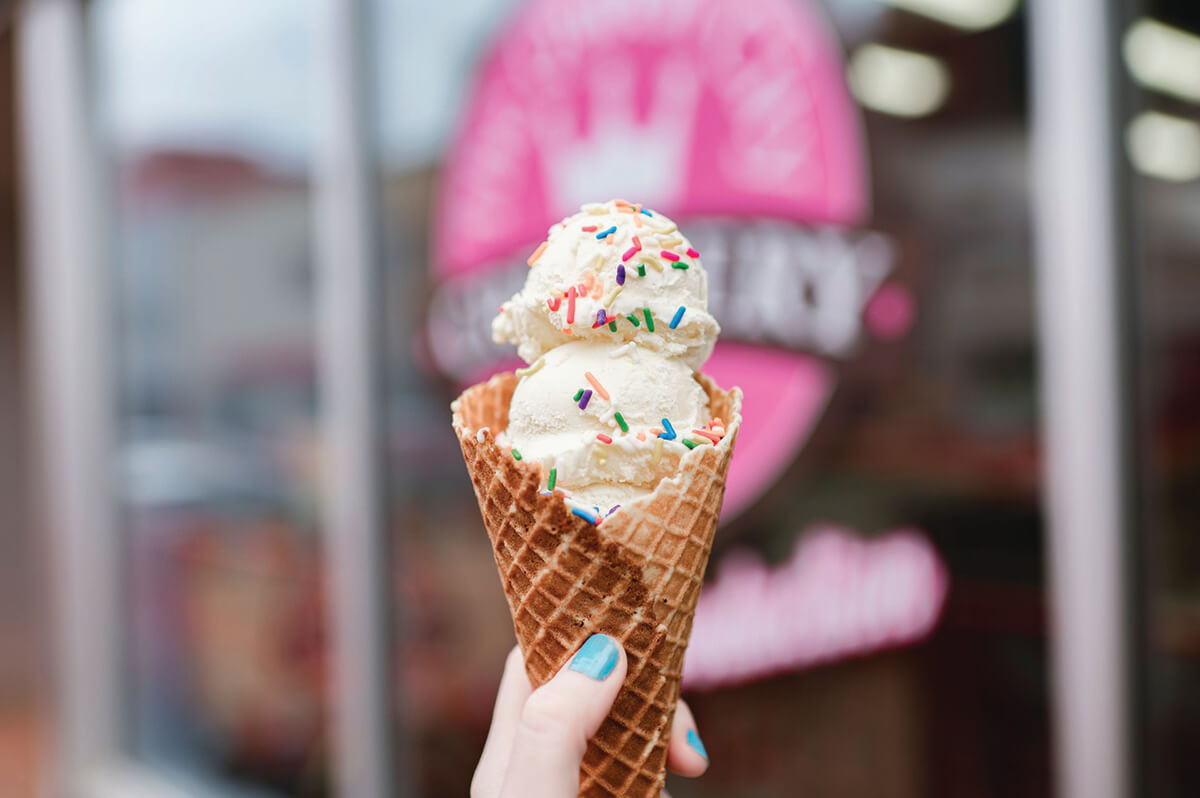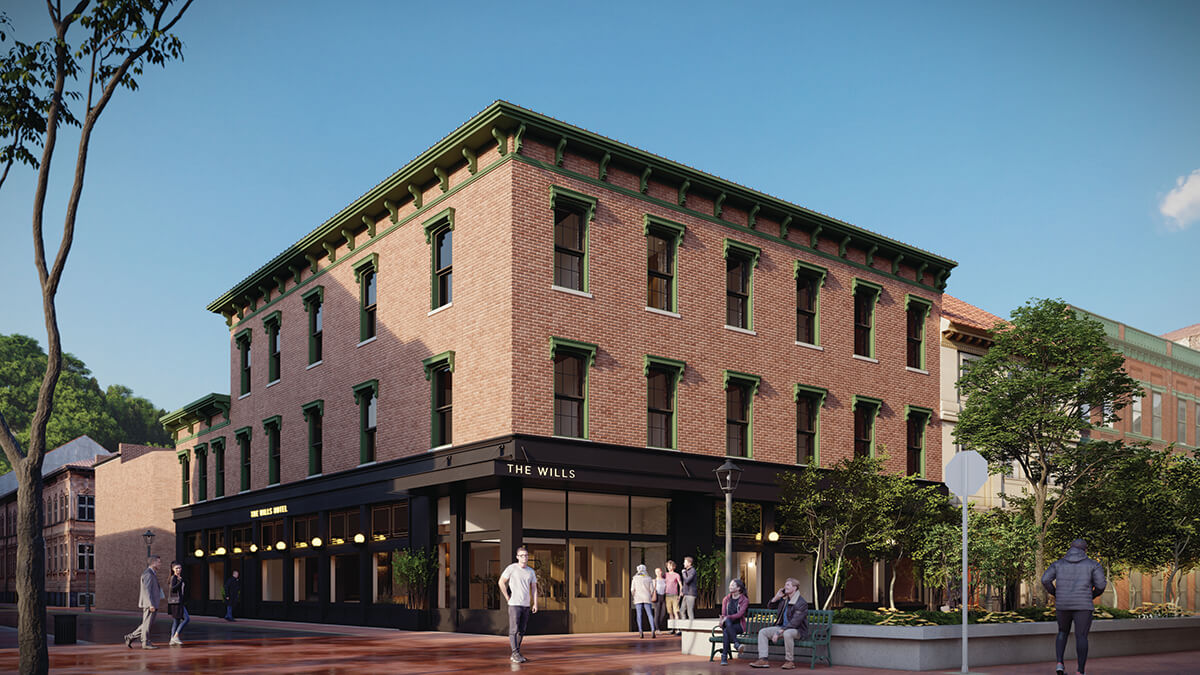Travel & Outdoors
Now is the Time to Plan a Trip to Cumberland, Maryland
Thanks to a $17-million renovation to its main drag, the scenic Western Maryland city is enjoying new life.

When Rhiannon Brown relocated the Queen City Scoop Shop in downtown Cumberland last year, she hung a sign inside that says “BELIEVE.” The Cumberland native borrowed the slogan from a community advocacy campaign in Baltimore from the years she lived there. It inspired the educator-turned-entrepreneur to revisit her roots and buy a beloved frozen custard store.
Brown isn’t alone. She’s one of about 20 small business owners—both Cumberland-raised and come-heres—who’ve bet on themselves and the future of this scenic, once-industrial Western Maryland city, which recently completed a $17.2-million downtown revitalization.
For many, Cumberland is the gritty city that Interstate 68, aka “The National Freeway,” passes over—literally and figuratively—as it dips briefly between mountains in Allegany County. If you’ve never visited, or haven’t in years, it’s time to exit the highway and explore Cumberland’s outdoorsy appeal, its surprisingly rich history, and its emerging culinary and arts scenes.
When work got underway in early 2023, Cumberland’s main drag, Baltimore Street, belonged to an endangered commercial species—the pedestrian mall. Left behind by shopping centers and e-commerce, served by an electrical grid so outdated it struggled to light the city’s Christmas tree, many of its businesses had either moved or closed.
Today, the area has re-opened for business in a big way. Once-empty storefronts hold a veritable United Nations of restaurants, plus crowded coffeehouses, a new visual and performing arts gallery, and a growing number of specialty shops. A boutique hotel—Cumberland’s first—will open later this year in a renovated Victorian-era building, one of the city’s many architectural gems.
Thanks to major upgrades in water, sewer, and electrical systems—as well as the introduction of 5G internet—some buildings house modern office and residential spaces on their upper floors. (A 2024 city program dangled $20,000 relocation packages for those willing to move here. The gambit drew national media attention and, to officials’ surprise, far more applicants than expected.)
Traffic flows again, slowly, on a three-block stretch of brick-paved Baltimore Street. Its now curb-less sidewalks are wider and re-landscaped to accommodate pleasant outdoor dining areas bordered by planters brimming with greenery. Trees that once hid the façades of stunning old buildings have been replaced with flora that gracefully frame them. There are new benches, streetlights, bike racks, a cascading wall fountain, and—for the first time in almost 50 years—on-street parking.
For much of its nearly 240 years, the “Queen City” was a fortuitously located transportation and industrial hub that rivaled Baltimore or Pittsburgh. Just west of Cumberland, Wills Creek cuts a deep, rocky-topped gap through the gently mounded Allegheny Mountains, opening a passage Cumberland Narrows—just wide enough for civilization to squeeze through on its roll westward centuries ago.
A path blazed by Native Americans became a wagon road and eventually Route 40, the nation’s first federal highway. From the east, the B&O Railroad arrived in 1842, and the C&O Canal linked the city to Washington, D.C., in 1850. Cumberland became a way station for travelers pursuing big dreams. Fur traders and settlers in the 18th century. Underground Railroad riders and commercial-rail tycoons in the 19th. George Washington arguably launched his early career here as a surveyor and a soldier before moving on to higher pay grades.

→ EXPLORE OUTDOORS
Today, big adventures are Cumberland’s primary attraction. The city of fewer than 20,000 lures more than 300,000 annual visitors: cyclists and hikers traveling the C&O Canal towpath and the Great Allegheny Passage (which meet here), sightseers riding the Western Maryland Scenic Railroad, and outdoor enthusiasts eager to explore Allegany County’s boundless beauty.
Begin your orientation at the Allegany Museum, whose impressive collection of 50,000 artifacts traces local history from Cumberland’s frontier days through its golden era as a maker of glassware, beer, tires, textiles, iron, and steel. Don’t miss the scale model of Fort Cumberland, a hillside British outpost built in 1754. Washington served as a young aide-de-camp there and the museum features a spectral 3D bust of our first president “reverse aged” by artificial intelligence to resemble his 1750s visage.
Allow ample time to explore nearby Canal Place Heritage Area, where centuries of transportation lore converge around C&O Canal National Historical Park. A pedestrian-friendly plaza with a shaded picnic area, it’s also home to the 1913 Western Maryland Railway Station. This grand reminder of Cumberland’s rail prominence still welcomes passengers. Western Maryland Scenic Railroad offers seasonal roundtrip excursions that chug through the Cumberland Narrows to the mountain town of Frostburg. Rail buffs will love Locomotive 1309, one of the nation’s largest still operating vintage steam engines.

The station platform faces Riverfront Park, a scenic strip overlooking the confluence of Wills Creek and the North Branch Potomac River, as well as the canal turning basin. Check out The Cumberland, a full-scale, landlocked replica of a canal boat and visit the C&O Canal Visitor Center & Museum, located in the rail station.
Canal Place marks the juncture of two famously scenic bike trails: the 184.5-mile C&O Canal Towpath and the 150-mile Great Allegheny Passage, aka “The GAP.” Traversed end to end, they link D.C. and Pittsburgh. Because it’s a readily accessible trail town, cyclists naturally come to Cumberland, and it to them, offering repairs, rentals, shuttle service, and even bike-washing stations.
Trailside at Canal Place you’ll find Wheelz-up Adventures, which rents, sells, and services bikes, and provides guided tours and shuttle service for cyclists. Owner Mandela Echefu also outfits and instructs climbers, hikers, mountain bikers, paddleboarders, and kayakers at two locations. “It’s all about getting people out- doors,” says the Nigerian-born Echefu, who, inspired by the area’s natural beauty, abandoned a health-care career to start the business with his wife, Jamie.

→ DRINKS AND DINING
Before leaving Canal Place, savor some trailside refreshment. Sample a flight of craft beers at Dig Deep Brewing Co., located in the historic Footer’s Dye Works Building. Dig Deep’s rotating selection of more than a dozen homebrews pays a sudsy nod to Allegany’s coal-mining heritage, with offerings like Pay Dirt brown ale. Steps away, Charis Winery & Distillery produces around 14 different wines using grapes grown almost exclusively in Maryland, as well as more than 18 kinds of rums, brandies, whiskeys, and liqueurs. Sip Afternoon Delight, a lovely mead-style wine, in Charis’ tasting room or on its inviting patio.
From Canal Place, you’re just two blocks away from the downtown historic district and its main thoroughfare, Baltimore Street. After 20 dusty months of construction, the refurbished area was unveiled at a ribbon-cutting last November. Defunct late 19th- and early 20th-century department stores, banks, and jewelry shops—their fancy façades still remarkably intact—are filled with new businesses and iconic enterprises that persevered through the construction.
Brown bought Queen City Creamery from its about-to-retire owners, keeping creamy frozen custard in Cumberland. Now called Queen City Scoop Shop, it offers more than two dozen flavors (the pistachio is excellent), and if yours happens to be the “name du jour” (check the sign board), you get a free scoop. Curtis Famous Weiners, a half-block off Baltimore Street, has been operated since 1918 by the Giatras family—Cumberland retail royalty whose original trade was candy-making. Slide into one of the restaurant’s vintage wooden booths, enjoy a Coney Island chili dog, and let garrulous owner Gino Giatras narrate family history as displayed on the shop’s memorabilia-lined walls.

Cumberland’s grand old stores—Rosenbaum’s, Schwarzenbach’s, McMullen Brothers, and Lazarus—are gone, but their ornate structures are being repurposed for 21st-century commerce. When Hayden Ort-Ulm sought a second location for his popular Greene Street coffeehouse, Basecamp Coffee Co., he landed in the old Rosenbaum building. This Baltimore Street coffee stand shares first-floor space in the refurbished 1899 building with Madison Paige Boutique, a chic women’s store; AJ’s Cookie Jar, specializing in French macarons; and Lefty’s Place, a new Detroit-style pizza and wing bar. Luxury lofts and Airbnb apartments are slated for the upper floors.
Basecamp’s Ort-Ulm, raised nearby in Bedford County, Pennsylvania, is another entrepreneur who’s come home—in his case all the way from the Pacific Northwest. He now lives 10 minutes away in La Vale, site of Basecamp’s roastery, and collaborates with businesses like Queen City Scoop Shop and Dig Deep Brewing on their coffee-flavored offerings.
Another morning buzz option is Café Mark, a favorite for specialty coffees, fresh-brewed teas, smoothies, and its creative breakfast and lunch menus. You’ll find a welcoming vibe (think brick walls and pressed-tin ceilings), killer breakfast burritos, and super-friendly servers. Just beware the pastry counter, which seduces you sweetly while you wait to order.
Other dining choices abound. Try Baltimore Street Grill, a cozy pub-style restaurant, for Cajun specialties including seafood gumbo, crawfish étouffée, and catfish strips. At Centre Street Collective, a festive food court, order at the bar from an internationally inspired menu, featuring wraps, flatbreads, breakfast bowls, sushi, and build-your-own ramen bowls. On Baltimore Street, City Lights American Grill does popular gourmet burger and-beer nights on Thursdays. Around the corner, Mise En Place offers French cuisine in a delightful bistro setting.
On Centre Street, Ristorante Ottaviani imports New York-style Italian fare to its romantic dining room. Order from the house specialty Abruzzo entrees and conclude your meal on a heavenly note with house-made warm butter cake. The restaurant’s less formal Tasting Room and Lounge serves brick-oven pizzas, salads, and charcuterie. Opened in 1906, Caporale’s Bakery on North Mechanic Street offers compulsory Cumberland noshes like fresh-baked pepperoni rolls (once a coal miner’s staple), Italian breads, and sugary confections.
→ NIGHTLIFE
Downtown’s most anticipated newcomer occupies the historic McCleave Building at 63-69 Baltimore Street. The 20-room Wills Hotel will be Allegany County’s first boutique lodgings when it opens, as early as this fall. Co-owner Brian Gilbride of Ohio, who cycles the GAP, was quite familiar with Cumberland. When he saw the Italianate-style building, he realized its potential. When completed, the three-story hotel—Gilbride’s “passion project”—will offer bespoke suites, a potential steakhouse with an adjoining bar, and first-floor space offering cyclists bike works, storage, and laundry facilities. Eyeing possible expansion, Gilbride also purchased the building next door.

Take your pick of after-dark diversions. Watch a play at Embassy Theatre, located in a landmark 1931 Art Deco movie house. Enjoy live music at Loft 129, which features everything from rock and pop to jazz and classical. Toss tools at Fore Axes, a bar catering to wannabe lumberjacks as well as aspiring Scottie Schefflers who can tackle simulation golf courses like Pinehurst, Torrey Pines, and Royal Melbourne.
One of downtown’s newest arts venues, Ferleman Gallery & Gallery Stage showcases contemporary art. Its intimate, intra-gallery stage hosts live acoustic music performances and boasts its own digital recording studio. Owners Thomas and Rebecca Ferleman, who moved to Allegany County to escape suburbia, plan to open RootSTable on the second floor, serving locally sourced New American cuisine. If you’re visiting the gallery this summer or fall, check out works by Baltimore’s own Joseph Sheppard, the noted sculptor, muralist, and portraitist who created the Brooks Robinson statue near Camden Yards.
→ LANDMARKS
Also discover some of Cumberland’s lesser-known landmarks. B’er Chayim Temple, an 1864 Greek Revival building downtown, is the longest continuously operating synagogue in Maryland, housing a congregation originally chartered in 1853. On a hillside overlooking Wills Creek, built atop Fort Cumberland’s remains, Emmanuel Episcopal Church in the Washington Street Historic District is well worth touring. The earthworks below—tunnels Washington once strode—were used a century later by African Americans following the Underground Railroad.

Walking the dimly lit space today is powerful and chilling. Inside the church itself, docent-led tours reveal another surprise. The chancel was designed by renowned artist Louis Comfort Tiffany, who personally visited and created three breathtaking stained-glass windows and several ornate candelabras.
When city leaders were planning the Baltimore Street Redevelopment Project, they dubbed the initiative “Reimagine Cumberland.” Now that the work is complete and downtown businesses have bought into the venture, they hope travelers will find the new Queen City as alluring as its predecessors.